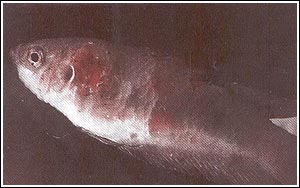 |
 |
The picture below was used with permission from "Handbook of Fish Diseases" by TFH Publications, Inc.
 Photo 1: Tuberculosis mycobacteria are found everywhere, including bottom gravel, debris and food remnants. It attacks fish when they are in a "weakened state," heavy crowding, or poor living conditions. It is usually a "secondary" infection.
Photo 1: Tuberculosis mycobacteria are found everywhere, including bottom gravel, debris and food remnants. It attacks fish when they are in a "weakened state," heavy crowding, or poor living conditions. It is usually a "secondary" infection.
Symptoms may include bloating, emaciation, open skin sores, popeye, jerky swimming, loss of appetite, staying in a corner of the tank, and/or spinal curvature. Skin sores appear as if "chunks" were torn out, with the edges bleeding. (Untergasser1989)
Successful treatment is rare at this stage. Euthanasia is recommended (Untergasser1989). Sterilization of all equipment is paramount. The aquarist must protect themselves as this bacteria could enter a human through a cut.
Source
Handbook of Fish Diseases by Dieter Untergasser, TFH Publications, Inc. 1989
Here are some links with additional information about Fish TB:
- http://www.bettadreams.com/diseases.html
In this link tetracycline is suggested as a possible treatment.
- http://www.petfish.net/bacteria.htm
In this link, some strains of TB are said not to grow at temps of 37 C (98 F), thus is specific to cold blooded fish. It is not sure how the disease is transmitted, but surmises it is transmitted from one fish to another, through water via skin and gills, or from food. The fishes immune system encapsulates the bacteria in "nodes." It is a slow process. Symptoms vary but may include, poor appetite, emaciation and a hollow belly or bloating. Popeye may also result. Sometimes open sores and curved spine occur. A more certain diagnosis is through autopsy, where the organs appear pale and enlarged, with grey –white nodules.
How it enters the aquarium is uncertain, but often will not show up even with 3 weeks of quarantine of an infected fish. Most fish TB is highly resistant to antitubercular meds. Good water quality and good food may help. Sanitary measures are necessary when dealing with the disease, including sterilizing all equipment and protecting the hobbyist with rubber gloves.
- http://www.fishyfarmacy.com/Diseases/Physical_Changes.html
In this article treatment is accomplished through the use of Isoniazid (1 tab/20 gal every other day) + Kanamycin (1/4 tsp/20 gal each day with a 25% wc each day). + vitamin B6 for 30 days.
- http://www.geocities.com/discus_aquarium/diseases.html
This link says there is no treatment, it's best to isolate.
- http://www.aquaworldnet.com/dbws/health.htm
This link states the signs and symptoms include, emaciation, not eating, spinal deformities, popeye, and swollen nodes. Treatment is through isolation.
- http://pub5.ezboard.com/fhobbyfrm14.showMessage?topicID=10.topic
In this article Jim Quarles states that the higher temps of Discus tanks + dirty conditions can be contributing factors. Wasting away occurs slowly, the fish slows eating, the eyes can protrude, dropsy can occur, the head appears to get bigger as the body shrinks. Prevention and early treatment of open wounds are the best medicine, as fungi may grow roots into the flesh where open wounds occur.
- http://www.thekrib.com/Diseases/fish-tb.html
At this link claims are made as to successful cure using medicated foods with antibacterial in it such as erythromyacin. Or using an injection of erythromyacin.
- http://userpages.umbc.edu/~rrhudy1/health.htm#bacteria
Oozing open sores are mentioned in this link. Bulges on the fish rupture. Kinked spines may occur. This disease may lie dormant for years according to the article, if the fish becomes stressed the disease becomes active. Some antibiotics that seem to work are tetracycline, erythromycin, sulfonamides, or minocycline, Some of these antibiotics are mixed in the foods and some were put in the water.
- http://www.aquarium.net/0897/0897_4.shtml
This link has many photos including microscopic photos, internal organs and fish. Stress sets the disease off along with unclean conditions. Discussion about the bacteria responsible for the disease is included. Treatment is a combination of doxycycline and Rifampin. Clean tank conditions, good water quality, good food, varied diet, water changes, good filtration, as well as vitamins help prevent the outbreak of this disease.
|
 |




 Photo 1: Tuberculosis mycobacteria are found everywhere, including bottom gravel, debris and food remnants. It attacks fish when they are in a "weakened state," heavy crowding, or poor living conditions. It is usually a "secondary" infection.
Photo 1: Tuberculosis mycobacteria are found everywhere, including bottom gravel, debris and food remnants. It attacks fish when they are in a "weakened state," heavy crowding, or poor living conditions. It is usually a "secondary" infection.
